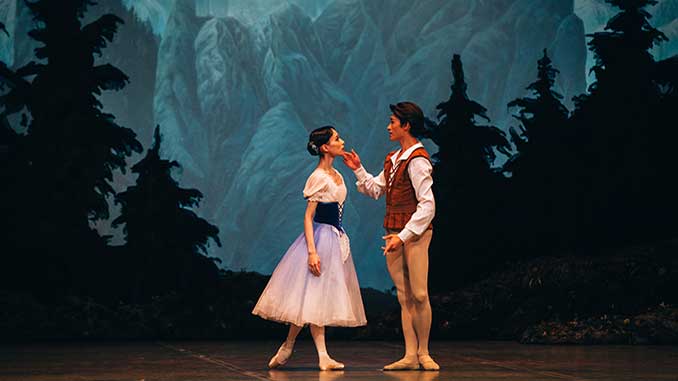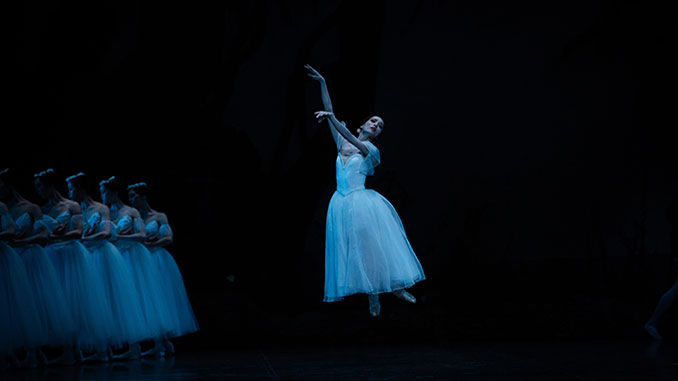 In a thoroughly captivating Australian debut on Friday evening, The Tokyo Ballet demonstrated their superb technical and artistic abilities and meticulous attention to detail under current Artistic Director Yukari Saito with the popular repertoire classical work, Giselle.
In a thoroughly captivating Australian debut on Friday evening, The Tokyo Ballet demonstrated their superb technical and artistic abilities and meticulous attention to detail under current Artistic Director Yukari Saito with the popular repertoire classical work, Giselle.
Since the company’s founding in 1964 – the same prideful year the city hosted the Summer Olympic Games – The Tokyo Ballet has regularly toured overseas. In the history of Japanese performing arts, its more than 35 overseas tours in over 155 cities is a record-setting feat statistically. It’s also a confidence-building foundation practically. Start to finish, on the State Theatre stage, not a nervous error was evident.
Saito plays it safely with one of the most-often performed classical ballets but pulling off one of the most challenging to dance is entirely another matter. That challenge is lavishly accomplished by the entire company in bringing this romantic tragedy to life.
Danced to Russian choreographer Leonid Lavrovsky’s 1944 version, this handed down historical artefact of sorts maintains a lineage back to the ballet’s 1841 premiere by choreographers Jean Coralli and Jules Perrot, including Marius Petipa’s late 19th century revision.
It’s an astonishing showcase of classical ballet expression and technique, spiced up with a dynamite pas d’huit in a four-by-two couple arrangement by Vladimir Vasiliev to replace Act 1’s Peasant pas de deux at the request of founding director Tadastugu Sasaki, a stunning, merry addition that further highlights the breadth of company talent.
It all relies on Adolphe Adam’s luscious score of cascading melodious treasures down in the pit. From its arousing whizz-bang introduction, conductor Benjamin Pope prevailed over a splendid sounding Orchestra Victoria with solo violin and harp sharing some special musical moments.
A two-act, day and night, real and supernatural contrasted romantic tragedy, Giselle upturns fairytale fortune with an intriguing story of unconditional love at its core but digs at the heels of power and privilege on its way.
It was revolutionary in its time but Giselle, to this day, forms a meaningful reflection on a young woman’s sense of betrayal by a deceptive aristocratic but who holds the balance of power in saving his life through her love and determination.
 For this, principal dancer Akira Akiyama conveyed Giselle‘s fighting, exuberant spirit with immense sensitivity and belief. From frightfully frail looking but empowered by dance as the weak-in-health, doe-eyed Giselle, Akiyama’s performance effortlessly reveals Giselle’s heart, her nimbleness, elegant lines and uncanny strength an intoxicating show of beauty.
For this, principal dancer Akira Akiyama conveyed Giselle‘s fighting, exuberant spirit with immense sensitivity and belief. From frightfully frail looking but empowered by dance as the weak-in-health, doe-eyed Giselle, Akiyama’s performance effortlessly reveals Giselle’s heart, her nimbleness, elegant lines and uncanny strength an intoxicating show of beauty.
Throughout the first act, Akiyama invites introspection and understanding, her concluding crazed dance a confronting sight as her limp, rag doll body spells Giselle’s death. In Act 2, Akiyama breathes spectacular life and conviction as a divinely transformed being, the featherlight, ethereal brilliance and contrasting vigour as the ghost of Giselle a remarkable sight to behold.
Yasuomi Akimoto’s florid and poised portrayal of the nobleman Duke Albrecht suggests rather stereotypically that not a hard day’s work has been done in his character’s life. Every movement appears calculated but his exceptional spatial drawings, centrality, springing leaps and legwork pay huge rewards.
Akimoto takes hold of Act 2 with especially notable feeling and expression, genuinely grieving Albrecht’s loss and ramping up the acrobatics with superlative results. In magical union with Akiyama, the pair dance the story’s tension-building trajectory marvellously with the final pas de deux a melting display of mature, refined and achingly heartfelt dance.
Giselle’s jealous peasant admirer Hilarion is painted with a touch of villainy, yet his persistence and love for Giselle and suspicions of Albrecht endear him increasingly – Junya Okazaki is highly impressive in the role. Cutting a muscularly heroic figure with wonderfully expressed movement, you wonder why Hilarion doesn’t send Albrecht packing when he has the chance.
In any case, Okazaki creates one of the most memorable highlights with a pulse-raising exhibition of impending demise as the his life is extinguished by the Queen of the Wilis – faultlessly danced with unyielding authority by Akimi Denda – and her mourning ghost brides.
In its own right, the corps de ballet is a breath-taking force of precision and homogeneity, a superbly synchronised unit when required and masterful in all manner of outstanding formations. While, as peasant folk, the spirit is joyous and energetic, it is the entrancing displays by the two dozen or so ghost brides that are the unforgettable highlight of their work.
Smaller roles are solidly filled with characterful, exaggerated style as part of designs that place the work in its Rhineland setting in the Middle Ages – Nicola Benois (sets and costumes) and Takashi Kitamura (lighting).
The quaint forest village, draped by autumnal foliage and the distant palace of Act 1 and contrasting grave-scattered and dark, eerie forest of Act 2, together with a smorgasbord of smart period-placing costumes and bell tutus, are a dazzling picture.
There is certainly room for such pieces but visionary it isn’t, raising the thought of how classical ballet can be more powerfully and meaningfully contemporised. Giselle offers plentiful scope. Nevertheless, the show goes on and The Tokyo Ballet’s welcome and spectacular appearance will no doubt trigger vivid and satisfying dreams. Yes, it’s true!
Giselle
State Theatre – Arts Centre Melbourne, 100 St Kilda Road, Melbourne
Performance: Friday 14 July 2023
Season continues to 22 July 2023
Information and Bookings: www.australianballet.com.au
Images: Akira Akiyama and Yasuomi Akimoto in The Tokyo Ballet production of Giselle – photo by Kate Longley | Akira Akiyama in The Tokyo Ballet production of Giselle – photo by Kate Longley
Review: Paul Selar
